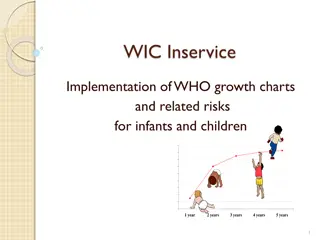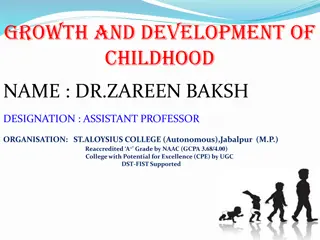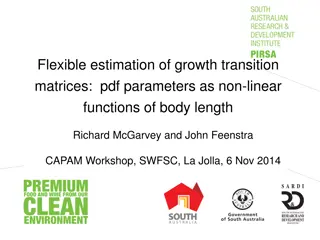Growth and Development
Growth and development refer to changes over time. Growth is quantitative, while development is qualitative and value positive. Human development aims to improve quality of life, opportunities, and freedoms. The Human Development Index (HDI) measures a country's social and economic achievements based on life expectancy, education, and income indicators. Learn about the origins of HDI, factors considered, and the pillars of human development.
Uploaded on Mar 14, 2025 | 1 Views
Download Presentation

Please find below an Image/Link to download the presentation.
The content on the website is provided AS IS for your information and personal use only. It may not be sold, licensed, or shared on other websites without obtaining consent from the author.If you encounter any issues during the download, it is possible that the publisher has removed the file from their server.
You are allowed to download the files provided on this website for personal or commercial use, subject to the condition that they are used lawfully. All files are the property of their respective owners.
The content on the website is provided AS IS for your information and personal use only. It may not be sold, licensed, or shared on other websites without obtaining consent from the author.
E N D
Presentation Transcript
GROWTH AND DEVELOPMENT Bothgrowthand development refertochangesoveraperiodof time. Growth:- Quantitative and value neutral change. Positive or a negativesign. Development :- Qualitativechangewhichisalwaysvaluepositive. Developmentoccurswhenpositivegrowthtakesplace. For example, if the population of a city grows from one lakh to two lakhs over a periodof time, wesaythecityhasgrown. However, if facilities like housing, provision of basic services and other characteristics remain the same, then thisgrowthhas not been accompanied by development.
The quality of life people enjoy in a country, opportunities they have and freedoms they enjoy, are importantaspectsofdevelopment. the The concept of human developmentwas introduced by Dr.Mahbub-ul-haq. Dr. Haq has described human development as development that enlarges people s choices and improves theirlives.
Access to resources, health and educationare the key areas in humandevelopment.
FOUR PILLARS OF HUMAN DEVELOPEMNT Just as any building is supported by pillars, the idea of human development is supported by the concepts of equity, sustainability, productivity andempowerment. Equity refers to making equal access to opportunities available to everybody. Sustainability opportunities. means continuity in the availability of Productivity productivity in terms of humanwork. here means human labour productivity or Empowerment meanstohavethepowertomakechoices.
WHAT IS HDI ? It is a tool used to measure a country's overall achievementin itssocialandeconomicdimensions. Definition:- The human development index (HDI) is a composite statistic of life expectancy, education, and per capita income indicators, which is used to rank countries into fourtiersof humandevelopment. The human development index is a measure of economic development and economicwelfare.
ORIGIN OFHDI Devised and launched by Pakistani economist Mahbub-ul- haq in 1990. Amartya Sen and Mahbub ul- haq worked upon the capabilities and functioning which provided conceptualframework. Published by United Nations Development Programme(UNDP). MAHBUB UL- HAQ AMARTYASEN
Thehumandevelopmentindexexaminesthreeimportantcriteriaof economic development Life expectancy Education Income levels Create an overall score between 0 and1. 1 - indicates a high level of economicdevelopment. 0- a very lowlevel. 1) 2) 3)
MEASURING HUMAN DEVELOPMENT The human development countries based on their performance in the key areas of health, educationand access toresources. index (HDI) ranks the Health :- The indicator chosen to assess health is the life expectancy atbirth. A higher life expectancy means that people have a greater chance of living longer and healthierlives.
Education :- Theadultliteracyrateand thegrossenrolmentratio represent access toknowledge. Thenumberof adultswhoareabletoreadand writeand the number of children enrolled in schools show how easy or difficultitistoaccess knowledge inaparticularcountry. Access to resources is measured in termsof purchasing power (in U.S.Dollars).
Example : Calculating HDI of India. Life expectancy index =0.679 Education index =0.495 Income index = 0.599 HDI = (LI * EI * II)^1/3 HDI = (0.679 * 0.495 *0.599)^1/3 = 0.586
INTERNATIONAL COMPARISONS Oftensmallercountrieshavedonebetterthan larger ones in humandevelopment. Similarly, relatively poorer nations have beenranked higher than richer neighbours in terms of human development. For example, Sri Lanka, Trinidad and Tobago havea higher rank than India in the human development index despite having smallereconomies. Similarly, within India, Kerala performs muchbetter than Punjab and Gujarat in human development despite having lower per capitaincome.
Ranking base:- Globally countries are divided in the following four classes according to their score in human development index
GLOBAL HDIRANKINGS- TOP TEN COUNTRIES RANK COUNTRIES HDI NORWAY 1 0.944 AUSTRALIA 2 0.933 SWITZERLAND 3 0.917 NETHERLANDS 4 0.915 UNITED STATES 5 0.914 GERMANY 6 0.911 NEW ZELAND 7 0.910 CANADA 8 0.902 SINGAPORE 9 0.901 DENMARK 10 0.900
LOWEST TEN COUNTRIES IN HDI RANK COUNTRIES HDI MOZAMBIQUE 178 0.393 GUINEA 179 0.392 BURUNDI 180 0.389 BURKINAFASO 181 0.388 ERITERIA 182 0.381 SIERRA LEONE 183 0.374 CHAD 184 0.372 CENTRAL AFRICANREPUBLIC 185 0.341 CONGO 186 0.338 NIGER 187 0.337
HDI ASPECTS OF INDIA India ranks (2014) 135 HDI 0.586 Gain of 0.003 HDI from previous year. Comes under medium human developmentcountries. Indicators: - Life expectancy at birth(by UN). Overall 64.19 years(Rank male 62.80 years. Female 65.73years. Education index : 0.473 . Mean years ofschooling : 5.1(rank 65). GNI(Gross National Income)per capita at PPP :$5350 (rank 127) . 147).
HDI PROGRAMME IN INDIA Unique in it skind. Preparation of not only national report, but also sub-national human development reports(HDR). Decentralized and integrated the human development concept into its developmentagendaatnational,state,aswellasdistrictlevel . More HDRs have been produced in India than the total number of global HDRs. Plan is made by the Planning Commission United Nations Development Programme(UNDP) preparation of State Human Development Reports (SHDR) District Human Development Reports(DHDR). partnership through the and
Human development programme started in plan(1992-1997). 8th five year First state- Madhya Pradesh. The world s first state HDR was published in Madhya Pradesh in 1995 . Computation of the state s HDI as well as HDI for all the districtsinthestatemadebystategovt. So far 21 states have preparedHDRs. State governments have initiated the work on district HDRs for 80 districts of which 23 HDRs have been released tilldate, 2009 -The first city HDR (Mumbai) waslaunched.
HDI-STATEWISE HDI of different states in India
LIFE EXPECTANCY STATEWISE State Life expectancy(YEARS) Kerala 74.0 Punjab 69.4 Maharashtra 67.2 Jharkhand , Chhattisgarh ,Madhya Pradesh 58.0
KERALA THE HIGHEST HDI STATE HDI - 0.764 LITERACY RATE 93.91 % LIFE EXPECTANCY 74 years. HIGHEST SEX RATIO 1084/1000. LEAST CORRUPTED STATE. CLEANEST AND HEALTHIEST STATE.
IMPORTANCE OF HDI The HDIgivesanoverall indexof economicdevelopment. It does give a rough ability to make comparisons on issues of economicwelfare much morethan justusing GDPstatisticsshow. It gives idea regarding areas of development which requires improvement. Statisticsgives betterdecision making forareashavingwidedisparity. More focus on social & human development rather than only capital accumulation andgrowth.
LIMITATIONS OF HDI Wide divergence within countries. For example, countries like China and Kenya have widely different HDI scores depending on the region in question. (e.g. :- North china poorer than southeast). Economic welfare depends on several other factors, such as threat of war, levels of pollution, access to clean drinking water etc. GNI does not show how the income is spent by the government. Some countries spend more on military than on healthcare.
When knowledge is measured it only takes into account what children learn at school not in the family. And so maybe knowledge statistics may be distorted if the family play more of a role in education in thehome. Longevity can also be distorted as the life expectancy of a person does notconsider how healthythelifewas led. Life expectancy value for a country is the given is an average of the total population. There are many communities in the country that will not all have access to good healthcare services and so there will be variations of life expectancy values.
THE CASE OF BHUTAN Bhutan is the only country in the world to officially proclaim the gross national happiness (GNH) as the measure of thecountry sprogress. Material progress and technological developments are approached morecautiously taking into consideration the possible harm environment or the other spiritual life of theBhutanese. they might aspects bring of cultural and to the
This simply means material progress cannot come at the cost of happiness. GNH encourages us to think of the spiritual, non- material and qualitativeaspects ofdevelopment.
WHY INDIA IS LAGGING IN HDI ?? Large number of population in India lives in slums that is around 158 .4 million. 42 % children below 5 years ageare underweight and 59 % stunted. Low spending on education by the government. Lack of schemes for urban poor like NRHM etc. India treats its environment poorly . Ranks 125 out of 132 countries in a studydone byYaleuniversity.
CONCLUSION The development. HDI gives an overall index of economic There are certain differences among different states development conditions so there must be equal opportunitiesfordevelopmentforall. Some important issues are missing in HDI such as infrastructureand someeconomicfactors.























